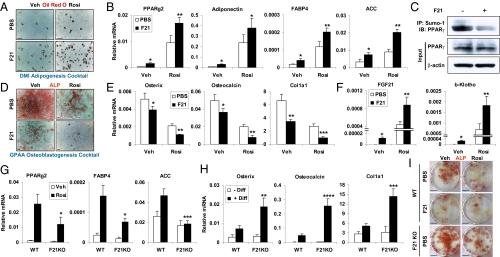Fig. 3.
FGF21 enhances adipogenesis and inhibits osteoblastogenesis in synergy with rosiglitazone. (A and B) Bone marrow cells from WT mice were differentiated into adipocytes ex vivo by using DMI (dexamethasone, IBMX, insulin) mixture in the presence or absence of FGF21 (0.2 μg/mL) and/or rosiglitazone (1 μM). (A) ORO-stained adipocyte differentiation culture. Mature adipocytes were ORO+ (red) cells. (Scale bars, 25 μm.) (B) Expression of adipocyte-specific genes (n = 3). (C) Immunoprecipitation analysis of the effects of FGF21 treatment (0.2 μg/mL, 4 h) on the levels of sumoylated-PPAR-γ in adipocytes differentiated from FGF21-KO bone marrow cells. IP, immunoprecipitation; IB, immunoblot. (D and E) Bone marrow cells from WT mice were differentiated into osteoblasts ex vivo by using GPAA (β-glycerophosphate, ascorbic acid) mixture in the presence or absence of FGF21 (0.2 μg/mL) and/or rosiglitazone (1 μM). (D) ALP-stained osteoblast differentiation cultures. Mature osteoblasts were ALP+ (red) cells. (Scale bars, 100 μm.) (E) Expression of osteoblast-specific genes (n = 3). (F) Expression of FGF21 and β-klotho in the adipocyte differentiation culture (n = 3). The P values in B, E, and F compare FGF21 and PBS treatments. (G) Expression of adipocyte-specific genes in the adipocyte differentiation cultures from WT or FGF21-KO mice with or without rosiglitazone (1 μM; n = 3). (H) Expression of osteoblast-specific genes in the bone marrow cultures from WT or FGF21-KO mice with or without osteoblast differentiation mixture (diff) (n = 3). The P values in G and H compare FGF21-KO with WT controls under the same treatment condition. (I) ALP-stained osteoblast differentiation cultures from WT or FGF21-KO mice, with or without FGF21 (0.2 μg/mL) and/or rosiglitazone (1 μM). (Scale bars, 0.5 cm.) *P < 0.05; **P < 0.01; ***P < 0.005; ****P < 0.001.

